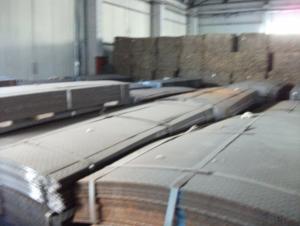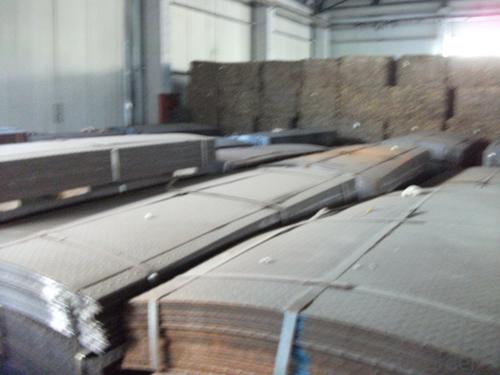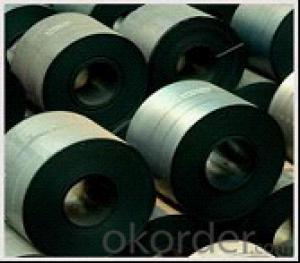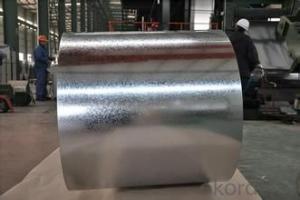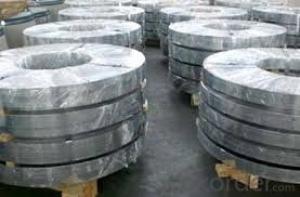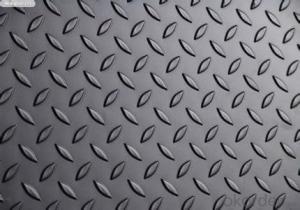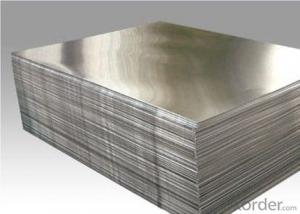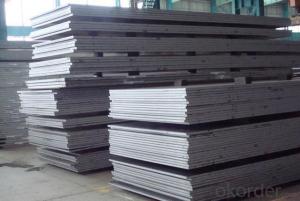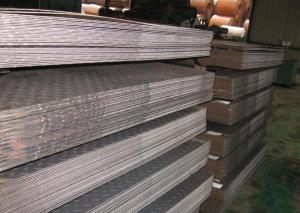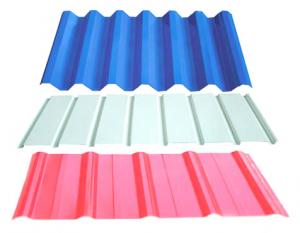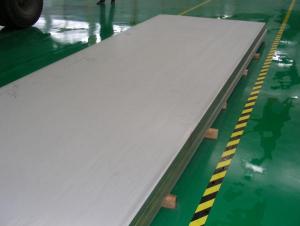hot rolled checkered plate
- Loading Port:
- China Main Port
- Payment Terms:
- TT OR LC
- Min Order Qty:
- -
- Supply Capability:
- -
OKorder Service Pledge
OKorder Financial Service
You Might Also Like
Product Description:
1, carbon steel rimmed steel sheet (GB3274-88)
Steel rimmed steel sheet as the name suggests is made by boiling hot rolled steel plate made of ordinary carbon structural steel. Rimming steel deoxygenation is a complete steel, steel liquid oxygen content is higher, when molten steel after the injection mould, carbon oxygen reaction to produce large amounts of gas, resulting in liquid steel was named after boiling state. Rimming steel with low carbon content, and because no FeSi deoxidization, so steel containing silicon amount <0.07%. Boiling steel outer layer is crystallized in the boiling state, so the surface clean, compact, good surface quality, good processing performance. Rimming steel no large shrinkage hole, deoxidizer used less, low cost of steel. Rimming steel heart of impurities, with the serious segregation, mechanical heterogeneity, more gas in steel, low toughness, cold brittleness and aging sensitivity is larger, the welding performance is poor, so it does not apply to manufacturing under impact load, welding pieces of the structure and other important components work under low temperature.
Steel plate used in the manufacture of all kinds of stamping parts, construction and engineering structure and the structure of the machine is not too important and parts of boiling. The grade, chemical composition and mechanical properties of the material with GB700-79 (88) (technical specification for steel structure of ordinary carbon steel provisions boiling). Hot rolled thick steel plate with thickness of 4.5-200mm. Production units are mainly of Anshan Iron and steel company, Wuhan, Maanshan Iron and steel, TISCO, Chongqing steel, Handan iron and Steel General Factory, Xinyu steel, Liuzhou steel, Anyang steel company, Yingkou plate plant of Tianjin steel and etc..
2 killed steel, plain carbon steel (GB3274-88)
Ordinary carbon steel plate is made of ordinary carbon structural steel hot-rolled steel billet sedation. Deoxidation fully killed steel is steel, steel liquid deoxidation ferromanganese, ferrosilicon and full aluminum ingot casting liquid steel in front, more calm in the mould, does not produce the boiling state, so named for the killed steel. Advantages of killed steel is uniform chemical composition, so the mechanical properties of each part is uniform, the welding performance and good ductility, corrosion resistance is strong. But the surface of poor quality, concentrated shrinkage, higher cost.
Ordinary killed steel is mainly used for structural components, production impact at low temperature welding structure, and other requirements of high strength. The grade, chemical composition and mechanical properties of the material with GB700-79 (88) (technical conditions of steel carbon structure) provisions in killed steel. Size thickness of 4.5-200mm plate. Anshan Iron and steel company, Wuhan Iron and steel are the main production units, Wuyang Steel Corp, Maanshan Iron and steel, TISCO, Chongqing steel, Handan iron and Steel General Factory, Xinyu steel, Liuzhou steel, Anyang, Tianjin, Yingkou Steel Corp steel medium plate plant, a steel, three factory, Shaoguan iron and steel plant and Ji'nan iron and steel factory.
3, low alloy structural steel (GB3274-88)
Low alloy structural steel plate is made of hot rolled low alloy structural steel. Low alloy steel plate is killed steel and semi killed steel sheet. The utility model has the advantages of high strength, good performance, can save large amounts of steel, reduce the structure weight etc.. Low alloy structural steel is more and more widely used in machinery manufacturing and metal structural parts. Thickness of hot rolled steel plate 4.5-200mm. The production unit including Anshan, Wuhan, Wuyang Steel Corp, Maanshan Iron and steel, Chongqing steel, Xinyu steel, Liuzhou steel, Kunming Steel Corp, Tianjin steel, Shaoguan steel plant, Anyang Steel Corp, a steel, three factory and taiyuan.
Steel plate hot rolling with 4, general structure (GB2517-81)
Mainly used for general structure of buildings, bridges, vehicles, etc.. Steel plate (belt) thickness from 1.2-13.0mm; width from 700-1550mm; the length from 2000-12000mm.
5, welded weathering steel with structure (GB4172-84)
Weathering steel is atmospheric corrosion resistant steel. Welding structure with weathering steel is adding small amount of alloying elements in steel, such as steel, chromium, nickel, molybdenum, niobium, titanium, zirconium and vanadium, which form a protective layer on the surface of a metal matrix, in order to improve the weathering steel, and good welding performance. Mainly used in bridges, buildings and other structures.
6, high weatherability, structural steel plates (GB4171-84)
Atmospheric corrosion resistance of weathering steel is economic. Adding small amount of alloying elements in steel, such as steel, phosphorus, chromium, nickel, molybdenum and niobium, titanium, zirconium and vanadium, the level of protection to improve the weathering resistance steel is formed on the surface of the metal substrate. Mainly applicable to buildings, vehicles, towers and other structures.
7, checkered steel plate (GB3277-82)
Pattern plate is the surface with diamond or lentil shaped rib plate. The specifications to the thickness (rib thickness excluding) said. The pattern plate is provided with antiskid effect, often used as a floor, workshop, working frame escalator pedal, the deck of a ship and car plate etc.. The pattern plate material with ordinary carbon structural steel B1, B2 and B3 grade steel rolling form, its chemical composition meet the GB700-79 (technical conditions of steel carbon structure) regulations. Production units are mainly the Anshan Iron and steel and Anyang Steel Corp.
Steel plate for 8, bridge (YB168-70)
The bridge plate is dedicated to the rack railway or highway bridge plate making. Load and impact requirements and has high strength, toughness and bear the locomotive and vehicle, and have good fatigue resistance, low temperature toughness of certain and atmospheric corrosion resistance. Tethered to the welding of bridge steel also has good welding performance and low notch sensitivity. The main structural element for a railway bridge and highway bridge span between 46-160mm. The specifications: thickness from 6-50mm, width, length from 1.0-2.4mm from 2.0-16mm. The production of bridges in China are mainly used steel Anshan, Wuhan steel, steel unit three factory and Chongqing steel etc..
- Q: Can steel sheets be used for manufacturing shipping pallets?
- Yes, steel sheets can be used for manufacturing shipping pallets. Steel is a strong and durable material that can withstand heavy loads, making it suitable for the construction of pallets. Steel sheets can be welded or bolted together to create a sturdy and reliable pallet structure. Additionally, steel pallets have the advantage of being resistant to moisture, pests, and fire, which can be important considerations for certain industries or applications. However, it is worth noting that steel pallets are generally more expensive than other materials such as wood or plastic, so the choice of using steel sheets for manufacturing shipping pallets would depend on specific requirements, budget, and intended use.
- Q: Q235 is hot rolled steel or cold rolled steel?
- Hot rolling and cold drawing is the difference of the production process of hot rolling is processed at high temperature, does not change the structure and properties of metal at high temperature, cold drawn round will be perforated, then in tube processing machine in the cold drawing, no tempering condition, this process will affect the crystal structure of metals. In general, better than the mechanical properties of cold rolled steel, after heat treatment, the tensile and yield strength, plasticity and toughness will be improved, in addition, heat treatment can eliminate the residual stress, and the cold may be because in the process of the steel yield the non-uniform deformation. The residual stress produced, the residual stress has great influence on the stability of.
- Q: Are steel sheets suitable for cryogenic applications?
- Yes, steel sheets are suitable for cryogenic applications. Steel is known for its high strength, toughness, and durability, which makes it capable of withstanding extreme cold temperatures. Additionally, steel is resistant to thermal stress and exhibits good thermal conductivity, making it a suitable material for cryogenic storage tanks, pipelines, and other cryogenic equipment.
- Q: How do steel sheets perform in harsh chemical environments?
- Due to their corrosion resistance properties, steel sheets are known to perform well in harsh chemical environments. Steel, an alloy composed mainly of iron, is strengthened by the addition of carbon, chromium, and nickel. These additional elements enhance the steel's ability to resist corrosion, making it suitable for use in environments where exposure to harsh chemicals is expected. Protective layers such as zinc or epoxy are often applied to steel sheets, providing an additional barrier against corrosive substances. These coatings serve as sacrificial layers, corroding in place of the underlying steel and prolonging the material's lifespan. Furthermore, steel sheets can undergo processes like galvanization, which involves applying a layer of zinc to the surface, thereby further enhancing their resistance to chemical corrosion. It should be noted, however, that the performance of steel sheets in harsh chemical environments can vary depending on the specific chemicals involved. Some chemicals, particularly those that are highly acidic or contain aggressive substances, can be highly corrosive to steel. In such cases, specialized stainless steel alloys or alternative materials may be more appropriate. In conclusion, steel sheets are commonly used in harsh chemical environments due to their durability and corrosion resistance. Nevertheless, it is crucial to carefully select the specific steel alloy, coatings, and additional protection measures to ensure optimal performance and longevity in these challenging environments.
- Q: How do steel sheets perform in terms of vibration damping?
- Steel sheets are known for their excellent vibration damping properties. Due to their high density and stiffness, steel sheets effectively absorb and dissipate vibrations, reducing their impact and preventing them from propagating further. This makes steel sheets a reliable choice for applications that require effective vibration control and noise reduction.
- Q: Are steel sheets suitable for pedestrian bridges or walkways?
- Yes, steel sheets are suitable for pedestrian bridges or walkways. Steel is a durable and strong material that can withstand heavy pedestrian traffic and provide a safe and stable surface for walking. Additionally, steel sheets can be customized to meet specific design requirements and can be easily installed, making them a popular choice for constructing pedestrian bridges and walkways.
- Q: How do steel sheets perform in terms of weathering?
- Steel sheets perform well in terms of weathering due to their inherent strength and durability. They are highly resistant to corrosion and can withstand harsh weather conditions such as rain, snow, and extreme temperatures. Additionally, steel sheets can be further protected through coatings and treatments, enhancing their ability to resist weathering and prolonging their lifespan.
- Q: What is the recommended storage method for the steel sheets?
- The recommended storage method for steel sheets is to keep them in a dry and well-ventilated area, preferably indoors, to prevent moisture and rust formation. It is also important to store them flat and adequately supported to avoid bending or warping.
- Q: Are steel sheets suitable for HVAC equipment?
- Yes, steel sheets are suitable for HVAC equipment. Steel is a durable and strong material that can withstand the demanding conditions of HVAC systems, such as high temperatures and corrosion. It is commonly used for ductwork, air handling units, and other HVAC components due to its excellent mechanical properties and resistance to wear and tear.
- Q: How do steel sheets handle electromagnetic interference?
- Due to their inherent electrical conductivity and magnetic permeability, steel sheets are highly effective in handling electromagnetic interference (EMI). These properties enable steel sheets to function as a barrier against electromagnetic waves, preventing their entry or exit from an enclosed space. When exposed to EMI, steel sheets act as a protective shield by reflecting and absorbing electromagnetic waves, minimizing their impact on electronic devices and systems. This shielding effect is particularly vital in sensitive environments like data centers, laboratories, and industrial facilities, where electromagnetic interference can disrupt electronic equipment and compromise functionality. The effectiveness of steel sheets in managing EMI is determined by their thickness and composition. Thicker sheets provide better shielding due to increased attenuation of electromagnetic waves. Certain steel alloys, such as carbon steel or stainless steel, offer enhanced EMI shielding capabilities. It is important to note that while steel sheets offer excellent EMI shielding, they are not completely impervious to electromagnetic waves. Factors such as wave frequency and the presence of openings or gaps in the steel sheet can affect the effectiveness of shielding. Consequently, proper installation and grounding techniques are essential to ensure optimal EMI protection. Overall, steel sheets are a dependable choice for mitigating electromagnetic interference and are preferred in various industries where EMI shielding is crucial for the uninterrupted operation of electronic devices and systems.
Send your message to us
hot rolled checkered plate
- Loading Port:
- China Main Port
- Payment Terms:
- TT OR LC
- Min Order Qty:
- -
- Supply Capability:
- -
OKorder Service Pledge
OKorder Financial Service
Similar products
Hot products
Hot Searches
Related keywords
